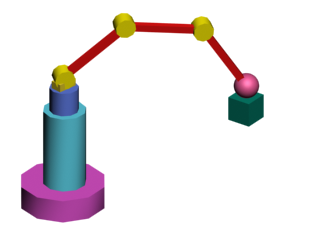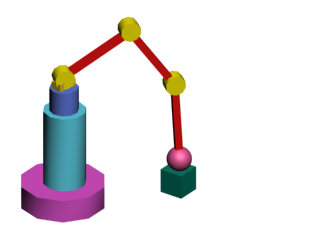With Interactive IK and the Auto Key button turned on, you position your model on keyframes, and the IK solution is interpolated between those keyframes. Because the IK solution accounts for multiple objects and the joints between objects, the interpolated animation of an IK object is usually different from the animation of objects without IK.
The following example demonstrates how an interactive IK animation works and how it might differ from what you expect. The figure shows an IK structure with its end effector resting on top of a box. The box moves in a straight line over 100 frames.
Turn the Auto Key button on and then in the Hierarchy panel  IK tab, turn on Interactive IK. Move the end effector of the IK structure to rest on top of the box at frame 100. The interpolated
animation of the end effector follows a natural looking curved path.
IK tab, turn on Interactive IK. Move the end effector of the IK structure to rest on top of the box at frame 100. The interpolated
animation of the end effector follows a natural looking curved path.
You might have expected the IK bone structure to follow the same path as the box. However, the IK solution is only calculated at the keyframes. The positions and rotations of all the objects in the kinematic chain are interpolated between the keyframes to produce the curved result.
To make the end effector closely follow the path of the box, you would have to add more keyframes. You can also use binding and standard applied IK. For information about making the end effector precisely follow the motion of the box, see Animating with Applied IK.

IK structure

Results of animating the box and IK structure
Behavior of Objects in IK Mode
As you move and rotate objects using interactive IK you notice that some objects might not be able to move or rotate about all axes. This is because the objects are constrained by the joint parameters you have set. If the joint parameters specify that motion cannot occur in a certain axis, the end of the chain will not move.
Behavior of Root Objects in IK Mode
An option on the Inverse Kinematics panel of the Preference Settings dialog enables the special case of moving and rotating root objects when IK mode is on. The name of this control is Always Transform Children Of The World.
While you are transforming an end effector using IK mode, the settings for the root object’s joint parameters are used and the root object does not move with respect to the World. If you select the root object, its joint parameters are released and you can transform the root object.
If you decide you want root objects to always use their joint parameters, you can turn off the Always Transform Children Of The World option.
Single, unlinked objects are hierarchies of one. An unlinked object is its own root and is also a child of the World. Turning Always Transform Children of the World will prevent you from transforming single objects in IK mode.